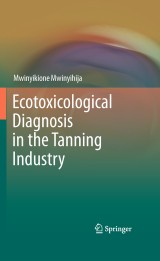Details

Ecotoxicological Diagnosis in the Tanning Industry
|
CHF 118.00 |
|
| Verlag: | Springer |
| Format: | |
| Veröffentl.: | 11.09.2010 |
| ISBN/EAN: | 9781441962669 |
| Sprache: | englisch |
| Anzahl Seiten: | 140 |
Dieses eBook enthält ein Wasserzeichen.
Beschreibungen
The tanning industry is a major source of pollution worldwide, particularly in developing countries. The major public concern over tanneries has traditionally been about odours and water pollution from untreated discharges. Important poll- ants associated with the tanning industry include chlorides, tannins, chromium, sulphate and sulphides as well as trace organic chemicals and, increasingly, synthetic chemicals such as pesticides, dyes and finishing agents, as well as solvents. These substances are frequently toxic and persistent, and affect both human and environmental health. The primary focus in this book was to identify the recently developed ecoto- cological analytical trends (rapid, simple and inexpensive) related to the tanning industry on terrestrial and aquatic systems. The resultant research data reported, incorporates both field related and laboratory based techniques to address under- ing environmental problems in the tanning sector. The book also includes a chapter to explore the occupational hazards in a tannery environment caused by conta- nated dust. It was important to note that an optical set-up involving microscopy and digital imaging techniques was initially used to determine dust particle numbers and size distributions as a preamble to ascertaining the dust toxicity levels.
Main Pollutants and Environmental Impacts of the Tanning Industry.- Ecotoxicological Techniques and Assessment of Environmental Samples.- Occupational Risk in the Tanning Industry.- Ecological Risk Assessment (ERA) of a Tanning Industry.- General Discussion.
Dr. Mwinyihija's current research interests include impact of salt to the terrestrial/aquatic environment as a pollutant of the tanning industr, recovery mechanisms of river sediment on pollution load, determination of particulate matter and its ecotoxicological potency in the environment, and dynamics of diffuse contamination.
With a wide experience spanning over thirty years in the Leather subsector Dr. M Mwinyihija embarked on his doctoral studies at the University of Aberdeen, focusing on the latest ecotoxicological and novel techniques that could provide environmental diagnostic insights to the tanning industry. Certain criterion was fundamental in writing this book; that the tanning industry is a major source of pollution worldwide, particularly in developing countries. Indeed the developed ecotoxicological and analytical techniques were deliberately designed on the basis of being rapid, simple and inexpensive and directed towards resolving the tanning industry challenges on terrestrial and aquatic systems. Thus the resultant research data reported, incorporates both field related and laboratory based techniques to address underlying environmental problems in the tanning sector.
Identifying ecotoxicological impacts related to the tanning industry on terrestrial and aquatic systems. The research incorporates both field related and laboratory based techniques in the experimental design to address the underlying environmental problems in the tanning sector. Different initiatives were used throughout the research in order to establish the ecotoxicological impact of the tanning industry using the most current developed bioassays. Includes supplementary material: sn.pub/extras
Diese Produkte könnten Sie auch interessieren:

The History, Use, Disposition and Environmental Fate of Agent Orange

von: Alvin Lee Young

CHF 118.00















